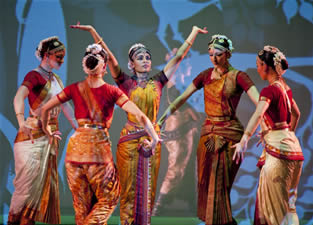Duke Chapel – lovely to look upon, awe-inspiring to visit – was the venue for the annual spring concert of the Vocal Arts Ensemble, surely one of the finest small choirs in captivity. Its director, Rodney Wynkoop is one of our region’s leading choral maestri, and he seems to lavish special affection and care on this elite group, whose members include the leaders of several other outstanding choral organizations, artists who routinely appear as soloists with other regional vocal ensembles, and a composer or two tossed in for good measure. (Indeed, with the active assistance of the 35 people named in the VAE program, one could create just about any new thing, vocal, that one might imagine.)
These VAE concerts have become ever more refined and generous, too, over the years. Time was when the goal may have been to have just enough to create a nice little CD, but this latest program lasted nearly an hour and three-quarters, minus the intermission. As has almost always been the case, from the very beginning, it proved to be one of the supreme musical highlights of the year, thanks to the superior voices, the superior leadership, and the astonishing – indeed, often breath-taking – precision of the execution, with every note fraught with meaning and emotion. It was a truly remarkable concert for a faithful description of which mere words are inadequate.
The words were Russian, Latin, French, and – mostly – English, and all of them – texts (transliterations, for the Russian number), and translations – were included in the 8-page program, in which even the page-turns were perfectly arrayed. The singers looked wonderful and sang that way, too, as the program, titled “A Nightingale Sings,” unfolded. The first half consisted of sacred music, starting with a fine example from the Russian Orthodox liturgy, Gretchaninov’s “Gladsome light” (or “Quiet radiance”). This chorus is equally divided – eight per section except for basses, of whom there are seven – and its members sing in quartets, so there’s no “sops on the left and basses on the right” arrangement. This takes some getting used to on the vocalists’ parts, but it’s the best way to ensure good balance, if the singers are sufficiently secure – as these pros are – to function without a same-range buddy to lean on. The other remarkable thing about this ensemble of vocal superstars is that they do blend, and in ways many lesser choirs, with lesser voices, seem incapable of matching. So in this first number were all these supreme qualities of balance and blend and diction and phrasing and dynamic shading and expression, and right from the first chord we knew that this would be another memorable, indeed remarkable concert – and it was.
Composer Paul Leary, a grad student in the Music Department and a tenor in the VAE, was represented by “Dum medium silentium” (“While all things were in deep silence”), a hauntingly beautiful, slow-moving piece in which the vocal strands were masterfully woven. Four solo voices graced the proceedings – sopranos Kristen Blackman and Elizabeth Terry, and altos Leigh J. Wynkoop and Erica Dunkle – and at the end, the composer received a big hand from the crowd.
Penderecki’s troubling “Agnus Dei,” part of the Polish Requiem, was next, and the choristers delivered it with heart-rending agony and grief, as if they were concurrently suffering the pain of which they sang. It was therefore something of a relief to have the ensemble turn to Howell’s unusual requiem, even though the pain the composer felt (at the premature death of his son) was often palpable. Still, it’s superficially serene, and in this performance, the great Gothic structure that we call Duke Chapel became, for the nonce, a venerable English cathedral, with the music undergirded by organist Jane Lynch. The soloists were soprano Patricia D. Philipps, alto Erica Dunkle, tenor Persio Logos, and basses Tom Jaynes and Larry Speakman, and to tell the truth, the performance seemed more inspired, more heart-felt, and, if you will, more authentic, in retrospect, than one given in February by the Guildford Cathedral Choir, in St. Michael’s Church.
The second half consisted of secular music, some of it, quite…. Elgar’s choral songs turn up rarely in concerts, and “There is sweet music,” with its strange juxtaposition of keys, is a fine specimen. Sung next to Eric Whitacre’s “Water Night,” it tended to hammer home the fact that some of today’s creators are very much the equals of somewhat more hallowed names from the past. Ross Lee Finney’s fascinating Spherical Madrigals may serve as a case in point; he gets little respect or recognition, but this six-section composition, launched by a simple little round, is a gem in every sense of the word. The singers did it handsomely, too, although in the opening salvo the chapel’s long reverberation period worked – despite Wynkoop’s vast knowledge and skill – to the music’s disadvantage.
At last, the nightingale appeared, in Lassus’ “Quel rossignuol,” introduced (as had been many of the other numbers) by Wynkoop, whose remarks heightened awareness and helped ensure the kind of active listening that the VAE’s performances merit – there’s no sitting back and letting the sound pour over you at these concerts! Still, the evening was not without its levity, as the last number demonstrated – ’twas the Swingle Singers’ wordless version of Rimsky-Korsakov’s “Flight of the Bumble-bee” (from The Tale of Tsar Saltan), offered, the director coyly informed us, because “after the birds come the bees.” But even that wasn’t enough for the audience, whose long and fervent demonstration finally resulted in “A Nightingale Sang in Berkeley Square,” a ’40s song revived by Manhattan Transfer, here featuring alto Laura Jones. This was, in a word, unexpected, but it heightened the delight and sent the folks away smiling, which is sometimes a good thing to do.
(YouTube has Vera Lynn’s rendition of “A Nightingale Sang” at http://www.youtube.com/watch?v=naC0PIL0EXE – and Manhattan Transfer’s, too – at http://www.youtube.com/watch?v=NNHDKxjZBiQ.)











